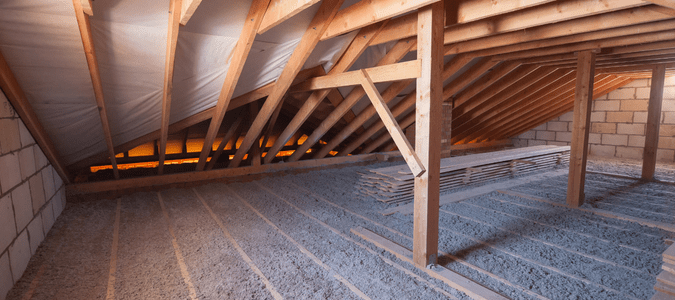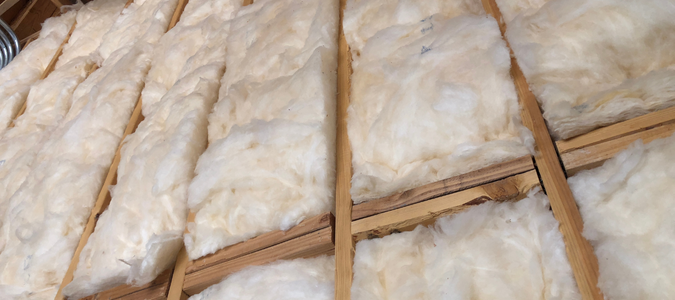When the temperatures are high or low, we count on insulation to help us be comfortable in our homes. It’s important to learn how insulation works and what type suits your specific situation best.
The first thing to know is that insulation has an R-value. This measures how resistant the insulation is to heat flow. The higher the R-value, the more resistant the material is to heat transfer. The recommended R-value varies according to where you live, the type of insulation you have and its thickness and density.
Typically the higher the R-value, the better the climate control and energy efficiency. Most homes have insulation in the attic and under floors that are above unfinished basements or crawl spaces. It is most effective when placed along exterior walls and basement walls. It can also be helpful to add insulation to attics and crawl spaces. Regardless, it doesn’t matter if your home is older or not. You can always improve your insulation. According to the North American Insulation Manufacturers Association, more than 90% of all homes do not have the right amount of insulation. So, what different types of insulation are out there and which one is the best for you?
Batt or Roll Insulation
This is the most common type of insulation. This insulation is made of fiberglass natural fibers, mineral weed or fiberglass and can come lined with or without kraft foil or foil. This can act as a barrier to both vapor and air.
This type of insulation is very easy to buy but comes in precut sizes, so you must compress it to fit your space. This type also has a relatively low R-value, so you will need to layer it for the proper effectiveness.
Form Board or Rigid Foam
These forms of insulation are quite sturdy and much more hardy than blanket rolls or batts. Foam works well internally or externally as wall sheathing or roof insulation, and can work in other areas of your home, too. This type of insulation is available in various materials and thicknesses.
Foam insulation is typically made with either polyisocyanurate or polystyrene. Polyisocyanurate has an R-value of 6.5 to 6.8 per inch. Polystyrene has an R-value of 5.0 per inch. Expanded polystyrene’s R-value is 3.8 per inch. All types of this insulation are expensive but offer almost double the R-value of any other option. They are stronger, more resistant to water, easier to work with and they are permeable to water vapor.
Insulated Concrete Forms
These are H-shaped forms made up of two concrete form walls between insulation layers. This type of construction includes open-air channels with an R-value up to R-20. They are typically reinforced with steel and can save you 20% of your heating and cooling bill. They also help control noise.
Blown-In Insulation
This is one of the most common types of insulation. It’s used in walls, ceilings, crawl spaces and attics. It is typically made of fiberglass, cellulose or mineral wood and sold in bags. You need special equipment to install this kind of insulation. Typically, this insulation has an R-value between 2.5 per inch to 4.2 per inch. Depending on the professional you work with, you may even be able to install blown-in insulation installed that also controls pests.
Loose fill insulation is generally more environmentally friendly since it’s made of recycled material. It is easy to use around areas that can be tricky, such as ductwork and pipes. Be sure to have an HVAC professional install this type of insulation as it can be susceptible to mold.
Radiant Barrier Insulation
Instead of resisting heat flow, radiant barrier insulation reflects it. It is easy to install and works better in hotter climates. That said, this type of insulation isn’t the best option for every homeowner.
Spray Foam and Foam-In-Place Insulation
This type of insulation can be sprayed, formed in or injected as a liquid that will then harden and expand. It costs more upfront, but it will save you money later on in weatherizing costs. Check with a professional to see what type of insulation is appropriate for your home.
Spray foam insulation gets into hard-to-reach areas and has a higher R-value than other types.
Structural Insulated Panels
These panels are rigid sheathing materials with insulating foam between them. They are factory-made and come in a variety of sizes. They are highly energy efficient and are easy to install. The panels also are generally covered in foil so it acts as a moisture barrier and can save you 12% on energy costs.
How to Remove Foam Insulation
Foam insulation is hard to remove for the same reasons it is great to install. It is highly recommended that you let the professionals handle this job. You will need to gear up if you choose to do this yourself. First, be sure there are no electric wires, pipes or plumbing under the area you wish to remove the foam insulation.
Next, you will need to get dressed for the job. Put on a mask and protective gear. This is essential.
Use a knife or tool to cut the insulation and pull it away from its installation. If you notice any remnants left behind, scrape them away with a flathead screwdriver or something similar. Then apply lacquer thinner for any residual insulation that remains. Do not use water to try to remove anything that remains. This causes the insulation to cure and get harder. Do not use heat to remove foam insulation. Contact an HVAC professional to handle this tough job efficiently.
How Much Insulation Do I Need?
The first thing you need to figure out is the kind of insulation you want to install. Then measure the height and width of each wall where you want to place insulation. Don’t forget to include the spacing for the studs, doors and windows. This kind of space makes up for any odd spacing in your configuration.
Once the measurements are set, you will need to divide by the package amount. It is helpful to seek the advice and expertise of a professional for this type of job. Your price will depend on the type of insulation, the R-value and the configuration of your space. Blown insulation costs more per square foot. The easiest solution is to consult with a licensed professional for any insulation help.
ABC Can Help You Save on Your Electric Bill
Everyone wants to save money on their heating and cooling costs and make their homes more energy-efficient. Installing insulation in your home can be dangerous and time-consuming if you are not an expert. If you want to make your home more energy-efficient, contact ABC Home & Commercial Services. Our HVAC experts can remove your old insulation and install new insulation for you. Additionally, we use a special type of blown-in insulation that not only insulates your home, but also keeps pests out.



